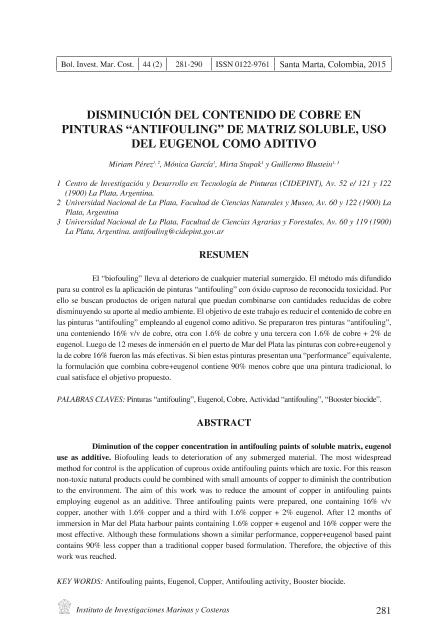Artículo
El biofouling lleva al deterioro de cualquier material sumergido. El método más difundido para su control es la aplicación de pinturas antifouling con óxido cuproso de reconocida toxicidad. Por ello se buscan productos de origen natural que puedan combinarse con cantidades reducidas de cobre disminuyendo su aporte al medio ambiente. El objetivo de este trabajo es reducir el contenido de cobre en las pinturas antifouling empleando al eugenol como aditivo. Se prepararon tres pinturas antifouling,una conteniendo 16% v/v de cobre, otra con 1.6% de cobre y una tercera con 1.6% de cobre + 2% de eugenol. Luego de 12 meses de inmersión en el puerto de Mar del Plata las pinturas con cobre+eugenol y la de cobre 16% fueron las más efectivas. Si bien estas pinturas presentan una performance equivalente, la formulación que combina cobre+eugenol contiene 90% menos cobre que una pintura tradicional, locual satisface el objetivo propuesto. Biofouling leads to deterioration of any submerged material. The most widespread method for control is the application of cuprous oxide antifouling paints which are toxic. For this reason non-toxic natural products could be combined with small amounts of copper to diminish the contribution to the environment. The aim of this work was to reduce the amount of copper in antifouling paints employing eugenol as an additive. Three antifouling paints were prepared, one containing 16% v/v copper, another with 1.6% copper and a third with 1.6% copper + 2% eugenol. After 12 months of immersion in Mar del Plata harbour paints containing 1.6% copper + eugenol and 16% copper were the most effective. Although these formulations shown a similar performance, copper+eugenol based paint contains 90% less copper than a traditional copper based formulation. Therefore, the objective of this work was reached.
Disminución del contenido de cobre en pinturas “antifouling” de matriz soluble, uso del eugenol como aditivo
Título:
Diminution of the copper concentration in antifouling paints of soluble matrix, eugenol use as additive
Fecha de publicación:
07/2015
Editorial:
Instituto de Investigaciones Marinas y Costeras José Benito Vives de Andréis
Revista:
Boletín de Investigaciones Marinas y Costeras
ISSN:
0122-9761
Idioma:
Español
Tipo de recurso:
Artículo publicado
Clasificación temática:
Resumen
Palabras clave:
Pinturas Antifouling
,
Eugenol
,
Cobre
,
Actividad Antifouling
,
Booster Biocide
Archivos asociados
Licencia
Identificadores
Colecciones
Articulos(CIDEPINT)
Articulos de CENTRO DE INV EN TECNOLOGIA DE PINTURAS (I)
Articulos de CENTRO DE INV EN TECNOLOGIA DE PINTURAS (I)
Citación
Perez, Miriam Cristina; Garcia, Monica Teresita; Stupak, Mirta Elena; Blustein, Guillermo; Disminución del contenido de cobre en pinturas “antifouling” de matriz soluble, uso del eugenol como aditivo; Instituto de Investigaciones Marinas y Costeras José Benito Vives de Andréis; Boletín de Investigaciones Marinas y Costeras; 44; 2; 7-2015; 281-290
Compartir




